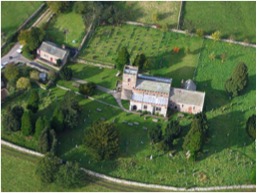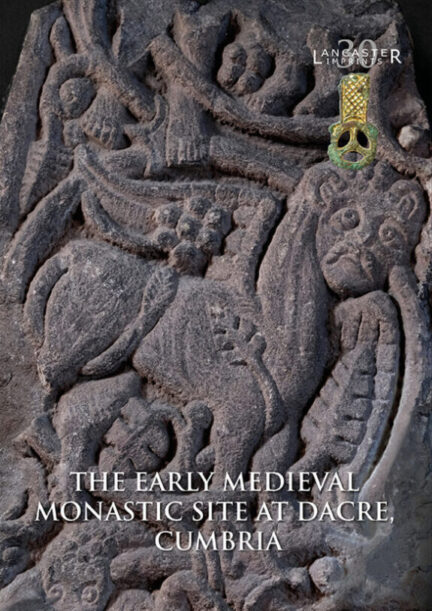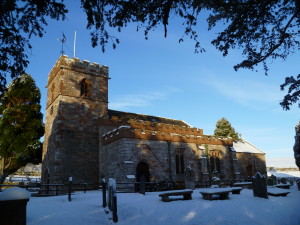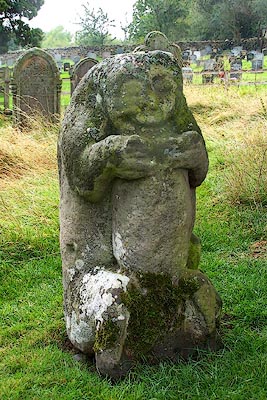
The church has a fascinating history and welcomes many visitors all year round. The Visitors’ Book records the comments of people who have traveled from all over the world and enjoyed the history, the architecture, and most of all the special tranquility of the church.
The first recorded reference to Dacre occurs in The Venerable Bede’s Ecclesiastical History of AD 731 in the context of the miracles attributed to St Cuthbert. A lock of Cuthbert’s hair was a relic at the monastery of Dacre when a young monk had a painful tumor on his eye. After handling the relic the tumor was gone within hours, and the monk was sent to Jarrow for the miracle to be recorded.
In William of Malmesbury’s 12th-century History of the Kings of England, Constantine, King of the Scots, and Owen, King of Cumbria, came to “a place called Dacor” to pay homage to the English king, Athelstan, and accept him as their overlord in AD934.
Archaeological evidence from the excavations in 1929 and 1982-84 supports the view that the present Norman church is built on the site of the monastery. Pre-10th century coffins, a Viking coin, and other pre-Norman artifacts have been discovered. The Saxon drain which was excavated was found to have been constructed with stones that were probably from a Roman bridge.
The present Norman church survived the turbulent border changes when the area was sometimes part of Scotland and sometimes part of England. The earliest known vicar was Nicholas of Appleby who vacated the living in 1296.
Various additions were made to the church in the 13th and 14th centuries, and from then on it remained unaltered until the 18th and 19th centuries when extensive restorations took place.
Further information about the interior is available there.
Dacre is famous for its four Bears, or as some now claim Lions, to be found in the church yard. Click on the image to see more information about them.
Are they the points the four Kings stood at as William of Malmesbury claims (see above)?
Are they something else … will we ever discover the secret?
Further information about the Church, the Bears is held on the Friends of Ullswater Way Web Site linked here.
Please note that a new monograph of the 1982-1985 excavations of the Dacre monastic site, undertaken by Oxford Archaeology North, has now been published and is available for purchase.
Kindly follow the link Dacre Early Medieval Book here.

Image curtesy of Oxford Archeology
Preface from Cumbria Books:
Dacre is rare in having documentary evidence for an early medieval monastery, mentioned by the Venerable Bede in 731, and in the twelfth century, William of Malmesbury thought that it was where King Aethelstan of Wessex met the northern and western lords in 927. High-quality early sculptural fragments and a substantial stone drain had also been found in the nineteenth- and early twentieth centuries. Excavations were undertaken in 1982-5, to the north and south of the parish church, and to the west of the churchyard, providing important information about its origins.
A substantial early medieval cemetery of more than 200 graves was found to the north, with some burialsin chests with iron fittings. Two structures were excavated to the west of this, one, with a rounded eastern end, containing a hearth made from a millstone. This was associated with a substantial assemblage of fine metalwork, loomweights, and vessel and window glass, and several Northumbrian coins were also found.
The drain in the southern churchyard was re-excavated, demonstrating that it was constructed of reused Roman stones, probably from a bridge or mill. An early ditched boundary was also identified, circling the south and west sides of the medieval churchyard, which seems to have followed its line. The early cemetery was later partially covered by a medieval farmstead, consisting of at least three buildings, one with a well-made fireplace.
This had become derelict by the fifteenth/sixteenth century, when the village either shrank or moved to the west, leaving the site very much as it is today.
Publisher: Oxford Archaeology North
Pages: 198
Publication Date: 2022-03-24
Format: Paperback; 298 x 210mm
ISBN: 9781907686375

